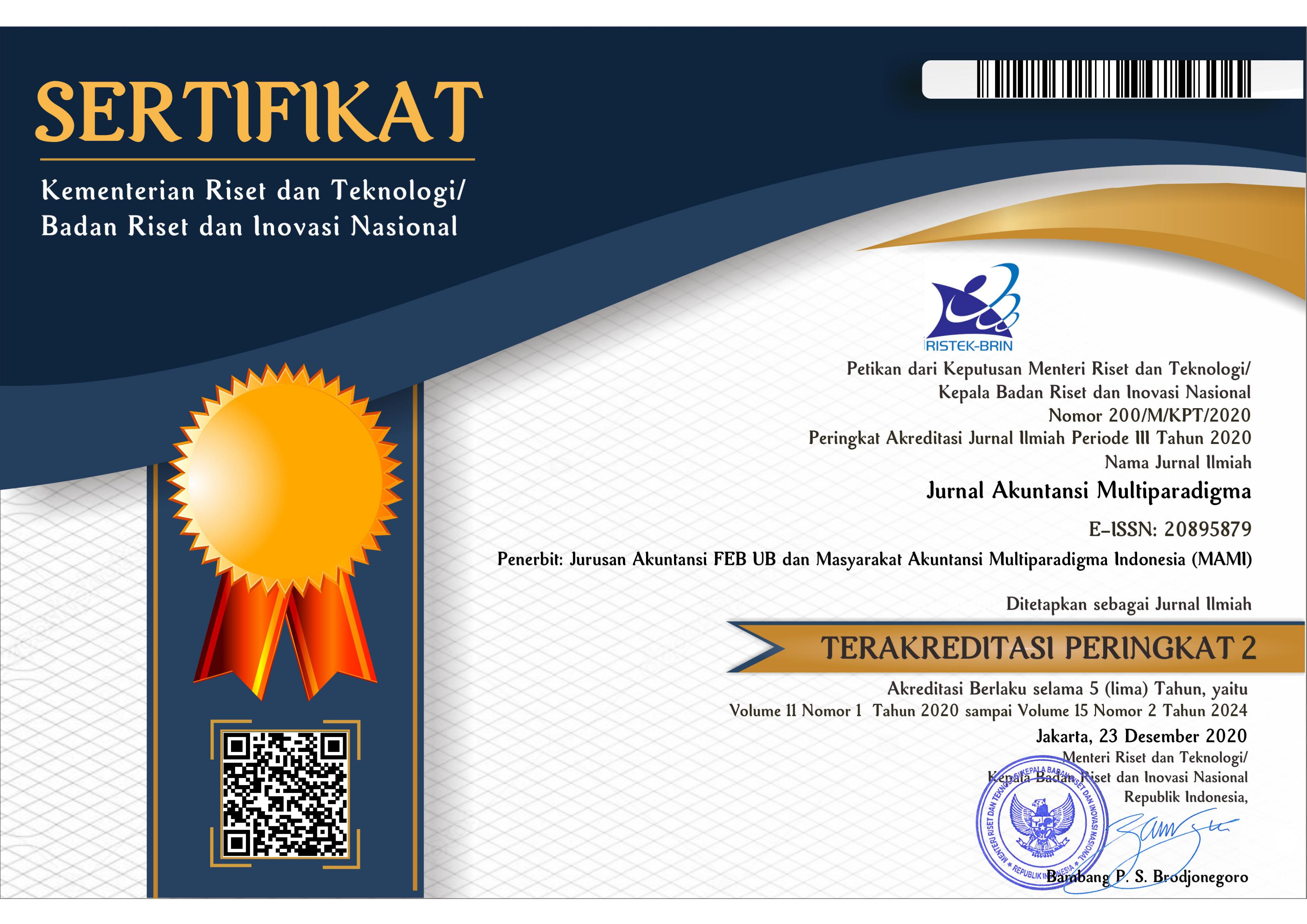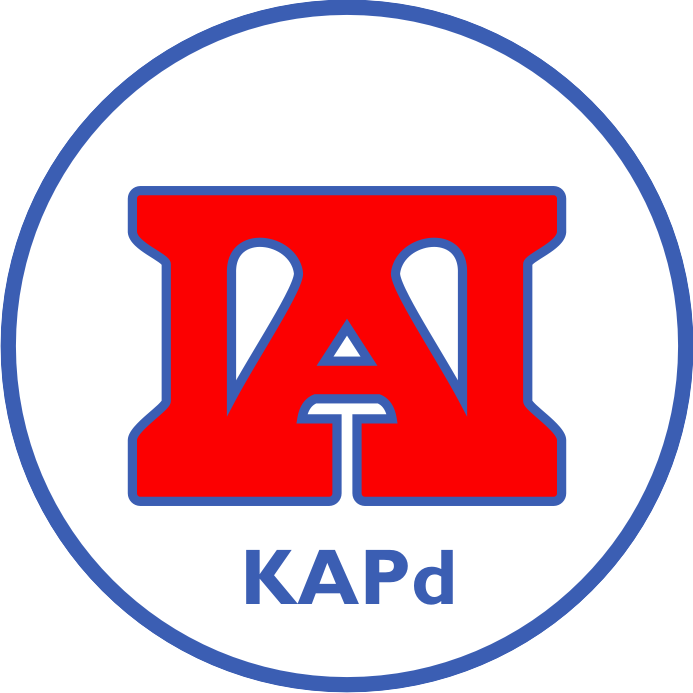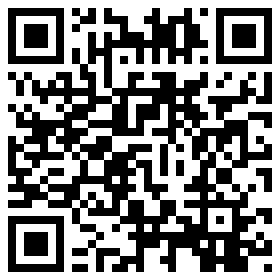GOING CONCERN DALAM METAFORA ONDEL-ONDEL
Abstract
Abstrak: Going Concern dalam Metafora Ondel-Ondel. Artikel ini berusaha mengungkap bahwa konsep going concern berlaku tidak hanya bagi perusahaan tetapi juga dalam budaya (dalam hal ini ondel-ondel dalam budaya Betawi). Metode yang digunakan adalah analisis semiotika terhadap ondel-ondel sebagai simbol keberlanjutan masyarakat Betawi. Hasil analisis menunjukkan bahwa ondel-ondel merupakan simbol dari “seniman jalanan.” Hal ini merupakan akibat logis dari perubahan sosial, teknologi, dan perspektif baru budaya modern. Meskipun demikian, simbol tersebut tetap disosialisasikan secara turun-temurun supaya tetap going concern dalam jangka panjang.
Abstract: Going Concern in Ondel-Ondel Metaphor. This article seeks to reveal that the concept of going concern applies not only to companies but also to cultures (in this case ondel-ondel in Betawi culture). The method used is semiotic analysis of ondel-ondel as a symbol of sustainability in Betawi society. The results show that ondel-ondel is a symbol of "street artists." This is the logical consequence of new social, technological, and cultural changes in modern culture. Nevertheless, the symbols are still socialized in order to keep going concern in the long run.
Keywords
Full Text:
PDFReferences
Amin, K., Krishnan, J., & Yang, J. S. (2014). Going Concern Opinion and Cost of Equity. AUDITING: A Journal of Practice & Theory, 33(4), 1-39. https://doi.org/10.2308/ajpt-50827
Attas, S. G. (2017). Seni Pertunjukan Cerita Si Pitung: Pertarungan Identitas dan Representasi Budaya Betawi. Arkhais: Jurnal Ilmu Bahasa dan Sastra Indonesia, 8(1), 68-79. https://doi.org/10.21009/ARKHAIS.081.08
Barthes, R. (2011). Mitologi. Bantul: Kreasi Wacana.
Bateman, J. A. (2017). Triangulating Transmediality: A Multimodal Semiotic Framework Relating Media, Modes and Genres. Discourse, Context & Media, 20, 160-174. https://doi.org/10.1016/j.dcm.2017.06.009
Bebbington, J., Russell, S., & Thomson, I. (2017). Accounting and Sustainable Development: Reflections and Propositions. Critical Perspectives on Accounting, 48, 21-34. https://doi.org/10.1016/j.cpa.2017.06.002
Bell, E. (2012). Ways of Seeing Organisational Death: A Critical Semiotic Analysis of Organisational Memorialisation. Visual Studies, 27(1), 4-17. https://doi.org/10.1080/1472586X.2012.642954
Blay, A., Moon, J. R., & Paterson, J. S. (2016). There's No Place Like Home: The Influence of Home-State Going-Concern Reporting Rates on Going-Concern Opinion Propensity and Accuracy. AUDITING: A Journal of Practice & Theory, 35(2), 23-51. https://doi.org/10.2308/ajpt-51290
Bryer, R. (2015). For Marx: A Critique of Jacques Richard's ‘The Dangerous Dynamics of Modern Capitalism (From Static to IFRS’ Futuristic Accounting). Critical Perspectives on Accounting, 30, 35-43, https://doi.org/10.1016/j.cpa.2014.09.004
Cabitza, F., & Mattozzi, A. (2017). The Semiotics of Configurations for the Immanent Design of Interactive Computational Systems. Journal of Visual Languages & Computing, 40, 65-90. https://doi.org/10.1016/j.jvlc.2017.01.003
Cassirer, E. (1987). An Essay on Man. Jakarta: PT. Gramedia.
Catchpowle, L., & Smyth, S. (2016). Accounting and Social Movements: An Exploration of Critical Accounting Praxis. Accounting Forum, 40(3), 220-234. https://doi.org/10.1016/j.accfor.2016.05.001
Christensen, L. T., & Askegaard, S. (2001). Corporate Identity and Corporate Image Revisited ‐ A Semiotic Perspective. European Journal of Marketing, 35(3), 292-315. https://doi.org/10.1108/03090560110381814
Davison, J. (2011). Barthesian Perspectives on Accounting Communication and Visual Images of Professional Accountancy. Accounting, Auditing & Accountability Journal, 24(2), 250-283. https://doi.org/10.1108/09513571111100708
Djamhuri, A. (2011). Ilmu Pengetahuan Sosial dan Berbagai Paradigma dalam Kajian Akuntansi. Jurnal Akuntansi Multiparadigma, 2(1), 147-185. http://dx.doi.org/10.18202/jamal.2011.04.7115
Efferin, S. (2015). Akuntansi, Spiritualitas, dan Kearifan Lokal: Beberapa Agenda Penelitian Kritis. Jurnal Akuntansi Multiparadigma, 6(3), 466-480. http://dx.doi.org/10.18202/jamal.2015.12.6037
Feng, N. C. (2014). Economic Consequences of Going Concern Audit Opinions in Nonprofit Charitable Organizations. Journal of Governmental & Nonprofit Accounting, 3(1), 20-34. https://doi.org/10.2308/ogna-50676
Finney, H. A. P. C., & Miller, H. (1959). Principles of Accounting Introductory. United Satates of America: Prentice Hall Inc.
Fitria, Y., & Syakura, M. (2017). Tabir Akuntabilitas “Keroan” pada Akuntan. Jurnal Akuntansi Multiparadigma, 8(1), 90-106. http://dx.doi.org/10.18202/jamal.2017.04.7042
Foster, B. P., & Shastri, T. (2016). Determinants of Going Concern Opinions and Audit Fees for Development Stage Enterprises. Advances in Accounting, 33, 68-84. https://doi.org/10.1016/j.adiac.2016.05.001
Fredlund, T., Linder, C., & Airey, J. (2015) A Social Semiotic Approach to Identifying Critical Aspects. International Journal for Lesson and Learning Studies, 4(3), 302-316. https://doi.org/10.1108/IJLLS-01-2015-0005
Glendening, M. (2017). Critical Accounting Estimate Disclosures and the Predictive Value of Earnings. Accounting Horizons, 31(4), 1-12. https://doi.org/10.2308/acch-51801
Gorichanaz, T. (2017). Auto-hermeneutics: A Phenomenological Approach to Information Experience. Library & Information Science Research, 39(1), 1-7. https://doi.org/10.1016/j.lisr.2017.01.001
Guston, D. H. (2014). Responsible Innovation: A Going Concern. Journal of Responsible Innovation, 1(2), 147–150. https://doi.org/10.1080/23299460.2014.937904
Hanan, D., & Koesasi, B. (2011). Betawi Moderen: Songs and Films of Benyamin S from Jakarta in the 1970s—Further Dimensions of Indonesian Popular Culture. Indonesia, 91, 35-76. http://doi.org/10.5728/indonesia.91.0035
Ittonen, K., Tronnes, P. C., & Wong, L. (2017). Auditors’ Going Concern Reporting Accuracy during and after the Global Financial Crisis. Journal of Contemporary Accounting & Economics, 13(2), 134-147. https://doi.org/10.1016/j.jcae.2017.05.005
Jo, T. H., & Henry, J. F. (2015). The Business Enterprise in the Age of Money Manager Capitalism. Journal of Economic Issues, 49(1), 23-46. https://doi.org/10.1080/00213624.2015.1013877
Kamayanti, A. (2016). Fobi(A)Kuntansi: Puisisasi dan Refleksi Hakikat. Jurnal Akuntansi Multiparadigma, 7(1), 1-16. http://dx.doi.org/10.18202/jamal.2016.04.7001
Kaplan, S. E., & Williams, D. D. (2013). Do Going Concern Audit Reports Protect Auditors from Litigation? A Simultaneous Equations Approach. The Accounting Review, 88(1),199-232. https://doi.org/10.2308/accr-50279
Krishnan, G. V., & Wang, C. (2015.) The Relation between Managerial Ability and Audit Fees and Going Concern Opinions. AUDITING: A Journal of Practice & Theory, 34(3), 139-160. https://doi.org/10.2308/ajpt-50985
Leiby, J., & Madsen, P. E. (2017). Margin of Safety: Life History Strategies and the Effects of Socioeconomic Status on Self-selection into Accounting. Accounting, Organizations and Society, 60, 21-36. https://doi.org/10.1016/j.aos.2017.07.001
Leone, M. (2013). The Semiotic Ideology of Semiotics: A Vertiginous Reading. Religion, 44(1), 92-98. https://doi.org/10.1080/0048721X.2014.866721
Lindawati, A., & Puspita, M. (2015). Corporate Social Responsibilty: Implikasi Stakeholder dan Legitimacy Gap dalam Peningkatan Kinerja Perusahaan. Jurnal Akuntansi Multiparadigma, 6(1), 157-174. http://dx.doi.org/10.18202/jamal.2015.04.6013
Macve, R. H. (2015). Fair Value vs Conservatism? Aspects of the History of Accounting, Auditing, Business and Finance from Ancient Mesopotamia to Modern China. The British Accounting Review, 47(2), 124-141. https://doi.org/10.1016/j.bar.2014.01.001
Maltby, J. A. (2017). Financial Reporting and Cultural History: A Contribution. Accounting, Auditing & Accountability Journal, 30(2), 472-474. https://doi.org/10.1108/AAAJ-04-2016-2519
Merkl-Davies, D. M.,& Koller, V. (2012). ‘Metaphoring’ People Out of This World: A Critical Discourse Analysis of a Chairman's Statement of a UK Defence Firm. Accounting Forum, 36(3), 178-193. https://doi.org/10.1016/j.accfor.2012.02.005
Mingers, J., & Willcocks, L. (2017). An Integrative Semiotic Methodology for IS Research. Information and Organization, 27(1), 17-36. https://doi.org/10.1016/j.infoandorg.2016.12.001
Mistry, V., Sharma, U., & Low, M. (2014). Management Accountants' Perception of Their Role in Accounting for Sustainable Development: An Exploratory Study. Pacific Accounting Review, 26(1), 112-133. https://doi.org/10.1108/PAR-06-2013-0052
Modell, S. (2015). Making Institutional Accounting Research Critical: Dead End or New Beginning? Accounting, Auditing & Accountability Journal, 28(5), 773-808. https://doi.org/10.1108/AAAJ-09-2013-1457
Moore, L. (2017). Revisiting the Firm, Reporting Entity, and Going Concern Concepts in Light of Financial Crisis. Accounting and the Public Interest, 17(1), 130-143. https://doi.org/10.2308/apin-51919
Niswatin, & Mahdalena. (2016). Nilai Kearifan Lokal “Subak” sebagai Modal Sosial Masyarakat Transmigran Etnis Bali. Jurnal Akuntansi Multiparadigma, 7(2), 171-188. http://dx.doi.org/10.18202/jamal.2016.08.7015
Nyamori, R. O. (2009). Making Development Accountable: A Critical Analysis of the Systems of Accounting and Accountability for the Constituency Development Fund in Kenya. Journal of Accounting & Organizational Change, 5(2), 197-227. https://doi.org/10.1108/18325910910963436
Piliang, A. Y. (2008). Hipersemiotika: Tafsir Atas Matinya Makna. Bandung: Jalasutra.
Pisano, R. (2016). Details on the Mathematical Interplay between Leonardo da Vinci and Luca Pacioli. BSHM Bulletin: Journal of the British Society for the History of Mathematics, 31(2), 104-111. https://doi.org/10.1080/17498430.2015.1091969
Ratzinger-Sakel, N. V. S. (2013). Auditor Fees and Auditor Independence—Evidence from Going Concern Reporting Decisions in Germany. AUDITING: A Journal of Practice & Theory, 32(4), 129-168. https://doi.org/10.2308/ajpt-50532
Read, W. J., & Yezegel, A. (2016). Auditor Tenure and Going Concern Opinions for Bankrupt Clients: Additional Evidence. AUDITING: A Journal of Practice & Theory, 35(1), 163-179. https://doi.org/10.2308/ajpt-51217
Rosman, A. J. (2011). Auditors' Going‐concern Judgments: Rigid, Adaptive, or Both? Review of Accounting and Finance, 10(1), 30-45, https://doi.org/10.1108/14757701111113802
Rospitadewi, E., & Efferin, S. (2017). Mental Accounting dan Ilusi Kebahagiaan: Memahami Pikiran dan Implikasinya bagi Akuntansi. Jurnal Akuntansi Multiparadigma, 8(1), 18-34. http://dx.doi.org/10.18202/jamal.2017.04.7037
Russell, S., Milne, M. J., & Dey, C. (2017). Accounts of Nature and the Nature of Accounts: Critical Reflections on Environmental Accounting and Propositions for Ecologically Informed Accounting. Accounting, Auditing & Accountability Journal, 30(7). 1426-1458. https://doi.org/10.1108/AAAJ-07-2017-3010
Sangster, A., Franklin, E., Alwis, D., Abdul-Rahim, J., & Stoner, G. (2014). Using Pacioli’s Pedagogy and Medieval Text in Today’s Introductory Accounting Course. Journal of Accounting Education, 32(1), 16-35. https://doi.org/10.1016/j.jaccedu.2013.12.001
Sitorus, J .H. E. (2016). Pancasila-based Social Responsibility Accounting. Procedia Social and Behavioral Sciences, 219, 700–709.
Sitorus, J. H. E., Triyuwono, I., & Kamayanti, A. (2017). Homo Economicus vis a vis Homo Pancasilaus: A Fight against Positive Accounting Theory. Pertanika Journal of Social Science and Humanities, 25(S), 311-320.
Smith, D., & Jacobs, K. (2011). “Breaking up the Sky”: The Characterisation of Accounting and Accountants in Popular Music. Accounting, Auditing & Accountability Journal, 24(7), 904-931. https://doi.org/10.1108/09513571111161648
Souza, C. S. D. (2012). The Semiotic Turn. Journal of Visual Languages & Computing, 23(2), 116-119. https://doi.org/10.1016/j.jvlc.2011.11.008
Suswandari. (2017). Local History of Jakarta and Multicultural Attitude (Historical Local Study of Betawi Ethnic). Journal of Education, Teaching and Learning, 2(1), 34-41. http://dx.doi.org/10.26737/jetl.v2i1.142
Svanberg, J., & Öhman, P. (2014). Lost Revenues Associated with Going Concern Modified Opinions in the Swedish Audit Market. Journal of Applied Accounting Research,15(2), 197-214. https://doi.org/10.1108/JAAR-11-2012-0077
Tabrani, P. (1992). Semiotika dan Bahasa Rupa Gambar. Jakarta: Pusat Penelitian Kemasyarakatan dan Budaya LPUI dan Lingkaran Peminat Semiotika
Thia, M. F. K. (2014). Travela: None Ondel-Ondel. Jakarta: Mizan.
Triani, N. N. A., & Satyawan, M. D. (2016). Memaknai Sisi Akuntansi Sumbangan Keagamaan Masyarakat Hindu Bali. Jurnal Akuntansi Multiparadigma, 7(2), 240-255. http://dx.doi.org/10.18202/jamal.2016.08.7019
Weygant, J. J., Kieso, Donald, E., & Kimmel, P. D. (2012). Accounting Principles (7th ed.). United Satates of America: John Wiley and Sons, Inc.
Young, A., & Wang, Y. (2010). Multi‐risk Level Examination of Going Concern Modifications. Managerial Auditing Journal, 25(8), 756-791, https://doi.org/10.1108/02686901011069542
Zhao, S., & Leeuwen, T. V. (2014). Understanding Semiotic Technology in University Classrooms: A Social Semiotic Approach to Powerpoint-Assisted Cultural Studies Lectures. Classroom Discourse, 5(1), 71-90. https://doi.org/10.1080/19463014.2013.859848
DOI: http://dx.doi.org/10.18202/jamal.2018.04.9006
Refbacks
- There are currently no refbacks.
Copyright (c) 2018 Chalarce Totanan, Natalia Paranoan

This work is licensed under a Creative Commons Attribution-NonCommercial 4.0 International License.

















